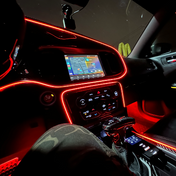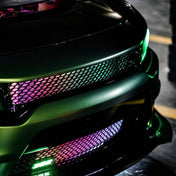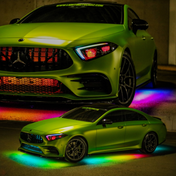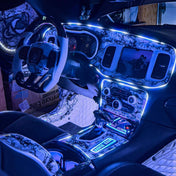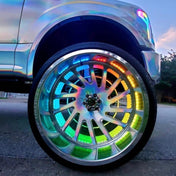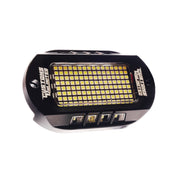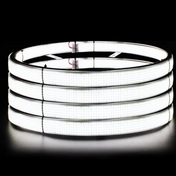1A. Opening Headlights (Butyl Rubber Sealed)
In order to separate the lenses on your headlights from the actual headlight housing, you will need to heat up the headlights to loosen the sealant holding the lenses to the housings. This can be achieved by bake them in the oven. After removing any mounting brackets or screws holding the lenses on, preheat your oven to 235-245 degrees and bake the headlights for 12-15 minutes. (Tip: Place the lights on a large baking pan or use aluminum foil on oven rack)
Once headlight has been heated for 12-15 minutes, remove them from the oven and use a flat head screwdriver or specialized prying tool and begin prying from one end of the headlight until you have worked around the entire light. You should start to see the lenses separating from the housings. If needed, repeat the heating process for 8-12 minutes and continue to pry around the light until the lens is completely separated.
Video below demonstrates the baking method of unsealing and resealing headlights with butyl rubber:
>>Here is a link to our butyl rubber sealant<<
1B. Opening Headlights (Perma-Sealed/Hard Sealant)
Some headlights are sealed with a hard sealant that cannot be heated up to loosen the bond. If your headlights are perma-sealed (hard glue/cement), you will likely need to cut them open. Here is a video below showing the cutting and resealing method:
Resealing cut headlights:
Step 1: Use a plastic welder, hot knife or soldering iron to melt the plastic back together (plastic weld). Click here for the plastic welder we recommend.
Step 2: Silicone around your weld (We recommend RTV waterproof silicone sealant, Permatex Silicone Adhesive Sealant #81173 or Permatex Ultra Black Gasket Maker)
Step 3: Smooth out your sealant
Step 4: Let sealant dry completely
Step 5: Inspect seal and test your headlights with a hose before reinstalling headlights back onto vehicle.
2. Disassembling Headlight Internals
Once the headlight is open, remove the pieces that you will be mounting the halos or DRL boards on. You will likely need to remove various screws in order to remove the factory LED boards. You will also need to unplug the factory DRL boards in order to remove them from the headlights.
3. Installing Halos/DRL Boards
For halo installation, first locate the area you plan to install the halo. Make sure the surface is clear of any dirt or grease. You can use the included 3M adhesive backing on the halos to stick them directly to the surface. You may need to drill a small hole to run the wire thru. If you need to remove the connector from the end of the wire, use a small metal flat-head or tweezers to push down the metal pins inside of the connector and you should be able to pull the connector off, exposing the metal pins and allowing you to easily push the wire thru the hole you have drilled. To put the connector back on, pry up the ends of the metal pins so they can slide back into the connector and lock into place. We recommend also using clear fishing line to secure they halos to ensure they do not come loose. Simply drill 1 or 2 small holes and loop the fishing line around the halo, then tightly tie a knot to ensure the halo cannot move.
For DRL board installation, simply remove the factory DRL boards and secure the new DRL board in its place. Typically you would reuse the factory screws or mounting points for the new DRL boards. If needed, you can use 2-part epoxy or quick drying glue to hold the DRLs in place, or use clear fishing line.
4. Preparing Headlights for Resealing
After installing all halos/DRL boards on the headlight internals, we recommend bench testing the halos/DRLs to ensure they are still properly working. You will need to drill a hole in the headlight housings to run the wires out. To ensure the headlight is still water-tight, we recommend using 11 to 13.5mm wire glands to run the wires out of the hole or using butyl rubber to cover the hole once the wires are ran thru. Heating up the butyl rubber will ensure that it sticks properly to the headlight housing. We also recommend drilling multiple vent holes and placing gortex patches over the holes to allow hot air to circulate out of the headlights. The gortex patches allow ventilation while also preventing moisture from coming in. Once you have a place for the wires to exit the headlight housings, you can reinstall all internal pieces on the headlights.
5. Sealing the Headlight (See videos at beginning of page)
If your headlights use butyl rubber for sealing, you can leave the original butyl in the headlight channel and on the lenses, but we do recommend adding more butyl into the channels to ensure they are fully sealed. You can stretch the butyl out to make it thinner if needed. Once the butyl rubber is installed, double check that the headlight internals are completely clean and that all factory connectors are reconnected and that all halo wires are ran outside of the headlights. Ensure the inside of the headlight lens is also clean. Then, put the lens loosely in place and press it down into the butyl channel so that the lens stays in place. Place the entire headlight back in the oven preheated to 235 degrees and bake it for 10-12 minutes to soften the butyl rubber. Once they are finished baking, use gloves to remove them from the oven, then use pressure or needle nose pliers to push the lens completely into the channel and also allow all clips to snap into place. If the headlights also have screws that secure the lenses, screw them back in while the headlight is warm/hot to ensure the lenses properly seat. Reinstall any bulbs, mounting hardware, brackets, etc. Once the headlights have cooled down completely (Both internally and externally), feel free to connect the halos to the wiring harness and test them out!
6. Wiring the Halos/DRLs
Flow Series/Color-Chasing Halos/DRLs *(Scroll down for standard RGBW)*

After installing the headlights on the vehicle, you will need to connect the halo/DRL wires to the provided wiring harness. We provide wire extensions for the headlights that are farthest away from where you install the wiring harness.
If you have a wring harness that has the sequential turn signal input wires (red, blue, and white single wires), you will need to splice the red and blue wire into the left and right turn signal + wires on the vehicle. You will need to research which wires these are or splice into a fuse.
White Braided Wire = DRL Input, all attached halos will turn white. When this wire receives power, the halos will turn white. Connect this to the vehicle DRL wire/fuse/signal if you intent to use this feature (optional).
Blue Braided Wire = Sequential Turn Signal Feature (1 Side) - If you connect this wire to the left turn signal, then you would connect the left side halos/DRL wires to the blue braided wire connectors on the wiring harness so they act as turn signals when the wire receives voltage.
Red Braided Wire = Sequential Turn Signal Feature (1 Side) - If you connect this wire to the right turn signal, then you would connect the right side halos/DRL wires to the red braided wire connectors on the wiring harness so they act as turn signals when the wire receives voltage.
BLUETOOTH APP: If your controller is a black box with a single 3-pin connector coming off of it, the app you need to download is Magic-LED Apple Link Android Link
If your controller is a white box with a single 3-pin connector coming off of it and says "LED Hue" on it, the app you need to download is LED Hue Apple Link Android Link
NOTE: PURE WHITE ON THIS CONTROLLER IS THE VERY BOTTOM SLIDER IN THE APP. THE TOP SLIDER IS FOR THE COLOR BRIGHTNESS. DECREASE THE TOP SLIDER ALL THE WAY AND INCREASE THE BOTTOM SLIDER FOR A PURE WHITE. IF YOU ARE USING COLORS, THEN DECREASE THE BOTTOM SLIDER ALL THE WAY.
After opening the app and connecting to the controller, please use the following settings:
Pixel/LED Type: SK6812_RGBW
Color Order: GRB
Pixel Count: 100 (This is the number of LEDs on the longest/largest component. You can increase/decrease this until the entire component is lit up)


7. Powering the Wiring Harness (Flow Series or RGBW)
The flow series wiring harness will now need to be connected to 12V+ and Ground/-. The wire with the inline fuse is the + wire, the other one without the inline fuse holder is -. You can connect these directly to the vehicles battery, but the harness will always be receiving power. This means that you will have to manually turn the halos/DRLs on and off every time you exit the vehicle. We recommend clipping the hoop connector off of the 12V+ wire and using an "add-a-fuse" or fuse tap and tapping the 12V+ power into a fuse that turns on/off with the vehicle or with a switch inside of the vehicle. All vehicles are different, so you will need to research or test which fuses are ignition-powered to do this. If you are going this route, then the ground/- wire will likely need to be connected to the frame ground nut that is located near the fuse box. It is a nut attached to the metal of the vehicle that the fuse box ground/- wires run to.
RGBW Demon Eyes/Halos/DRLs:

After installing the headlights on the vehicle, you will need to connect the Demon eye/halo/DRL wires to the PROPER LED DRIVERS FIRST. EACH LED DRIVER IS LABELED FOR WHICH COMPONENT IT IS FOR AND THE CONNECTORS ARE ALSO LABELED TO MATCH UP WITH THE HALOS/DRLS/DEMON EYES. DO NOT CONNECT THE HALOS/DRLS/DEMON EYES DIRECTLY TO THE CONTROLLER/WIRING HARNESS, YOU MUST CONNECT THEM TO THE LED DRIVERS OR YOU RISK DAMAGING THE LEDS PERMANENTLY! Each LED Driver has a black and yellow wire coming off of it. THE BLACK WIRE MUST BE PROPERLY GROUNDED IN ORDER FOR THE LED COMPONENTS TO FUNCTION PROPERLY. The yellow wire is for the turn signal feature and can be spliced into the vehicles + turn signal wire (optional). The yellow wire on demon eyes is a shut-off wire. When it receives power, it will turn the demon eyes off automatically. We highly recommend splicing this into one of the headlight + wires to signal the demon eyes to turn off when the headlights turn on to prevent the demon eyes from overheating and possibly failing. After connecting all LED components to the proper LED drivers and grounding the black wires, you can connect the LED drivers directly to the RGBW controller. (See section above for how to connect the controller to power). Download the Magic LED Light V2 app if you are using iOS. Download the Magic Light - BLE app if you are using Android. If you are using the RGBW Bluetooth controller and get the message "turn power off to controller then quickly reconnect", you need to click the "OK" button, quickly disconnect one of the power wires from power, quickly reconnect it, then go back in the app and click on the controller again. It should now allow access to the controller. This is done as a verification process to ensure it is your controller. You can click and hold down on the name to rename the controller if desired.

